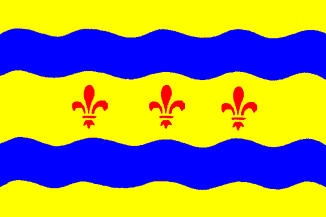 Shipmate Flagchart : http://www.flagchart.net
Shipmate Flagchart : http://www.flagchart.net
Adopted 20 Feb 1995

Last modified: 2014-06-28 by andrew weeks
Keywords: voerendaal |
Links: FOTW homepage |
search |
disclaimer and copyright |
write us |
mirrors
 Shipmate Flagchart : http://www.flagchart.net
Shipmate Flagchart : http://www.flagchart.net
Adopted 20 Feb 1995
![[Voerendaal old flag]](../images/n/nl-li_vo.gif) by Jarig Bakker, 4 Nov 2003
by Jarig Bakker, 4 Nov 2003
Voerendaal's old flag was: five horizontal stripes of red, white, black,
yellow, and blue, and in the canton the municipal arms.
Adopted 21 Dec 1976 by municipal resolution.
This flag is the old Limburg flag as used in 1938 as parading flag
in the Olympic Stadium in Amsterdam, when Queen Wilhelmina (and all of
us) celebrated her 40 years of blissfull reign of the Netherlands.
Municipalities used that flag with the addition of the municipal arms
in the canton.
Source: Derkwillem Visser's Gemeentewapens en vlaggen Koninkrijk
der Nederlanden, 2001.
Jarig Bakker, 4 Nov 2003
![[Voerendaal Coat of Arms]](../images/n/nl-li)vo.jpg) from the Voerendaal municipal site.
from the Voerendaal municipal site.
Till 1777 Voerendaal belonged to Heerlen, except for 1627-1634, when it was owned by Willem van Cortenbach. Since 1777 Voerendaal has its own government. Because Heerlen (and therefore Voerendaal too) was one of the main sheriff's benches of Valkenburg the lion of Valkenburg is represented on the arms. The person is Saint Lawrence, the patron saint of the church. The municipality originally asked for a mirror image of the arms, but the High Council of Nobility thought that the parish saint ought to be in the place of honor (first field), and turned the image.
![[Klimmen flag]](../images/n/nl-li_km.gif) by Jarig Bakker, 30 Apr 2005
by Jarig Bakker, 30 Apr 2005
Klimmen is a former municipality in Limburg province, since 1982 part
of Voerendaal.
Flag: Two stripes yellow - red; at the hoist charged with a triangle,
with apex at flagcenter, with stripes blue - white, the triangle
bordered black (border = 1/12 flagheight).
Adopted 29 Sep 1977 by municipal resolution; design: Stichting Banistiek
en Heraldiek.
The colors are derived from the municipal arms. The triangle symbolizes
the steep hill on which the village of Klimmen lies (Klimmen = to
climb), for which the village was known since medieval times, while the
background of the quarters of the arms have been used "inside the height"
as a vague reminder of the former mining tradition.
Nickname: "Molmuus" - vole, used for people who are sly like
rats or for busybodies.
Source: Vexilla Nostra 15 (108): p.50.
Groot Schimpnamenboek van Nederland, by Dirk van der Heide, 1998.
Jarig Bakker, 30 Apr 2005